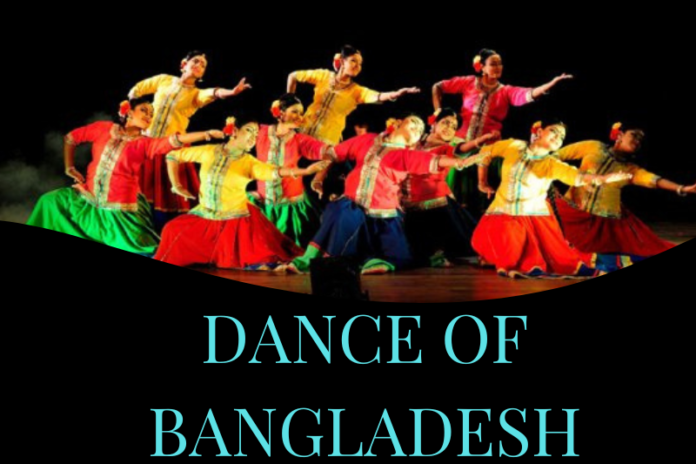One important way of expressing human emotions and cultures is dance. Its main aim is to awaken the aesthetic sense of people, inspire the enrichment of life, and at the same time evoke joy and emotions. Dancing has been practiced in Bengal since ancient times. New trends have influenced the country’s dance through the blending of different cultures over time. At present, newer styles can be noticed in local dances due to the influence of globalization. But modern dances have been greatly influenced by Western cultures.
Ancient Dance Culture:
Ancient people living in the forests used to gather inspiration and courage by singing and dancing before going out hunting. After hunting, they would express their joy by dancing around the hunted animals. After the introduction of agriculture, they used to express their emotions by singing and dancing before planting seeds and after harvesting. Besides, they also worshipped through dancing, especially the Hindus, Buddhists, and Christians. Descriptions of these dances are found in the writings of foreign travellers and geographers.
History of Dances:
There is mention of classical dances in the history of ancient Bengal. In the medieval age, Chaitanyadev, along with his disciples, introduced Sangkirtan. Lovers of Kirtan used to sing the virtues of Lord Krishna by playing tabor and cymbal and dancing in a circle. The art of dancing acquired further popularity during Mughal rule through the depiction of various mythological tales. At that time, new postures, rhythms, and pitches were introduced through experimentation. Forms of dance went through significant changes due to the influence of Western culture during British rule. Wealthy people brought dancing to their ballrooms to entertain guests. Dancing was gradually separated from the generality and became a form of entertainment for the rich only. However, the art of dancing became life-oriented after the independence of Bangladesh and flourished due to state patronage.
Classical Dance Worship:
The art of dancing, which started in ancient India and is centered on the Vedic religion, is known as classical dance. This type of dance was based on mythological themes. An aura of devotion was, therefore, visible in these dances. Only maidservants used to perform dance inside temples at that time. Gradually, classical dancing moved beyond the temples and flourished as art in society.
Folk Dance:
Folk dances evolved along the changing lifestyle of the people—their birth and death, love and separation, etc. These dances have no codified form. They evolved naturally as a part of cultural evolution. The folk dances of Bangladesh include formal dances, regional dances, seasonal and mythical dances, and story-based dances. Local musical instruments like drums, flutes, cymbals, etc. are played during these dances. These dances have occupied a place in the hearts of people.
Gambhir Dance:
Gambhir is a popular folk song in Bangladesh. It is popular in the Chapainawabgonj, Rangpur, Rajshahi, and Pabna regions. There are two singers in Gombhira songs. They dance while singing. They wear folk hats made from bamboo, and the main singer carries a stick in his hand. Holding the stick with both hands, he swings his buttocks while singing. The other person also dances in a similar fashion. Once, the farmers used to hold sessions of Gambhira song at the end of Bangla year to pray for rain. At present, this dance and song are often organized to generate awareness about various social issues.
Khemta Dance:
It is one of the ancient folk dances of Bangladesh. This dance has presented the issue of love between Radha and Krishna. This dance was once performed during marriage ceremonies in villages. The females who participate in Khemta dance are known as Nachni. The singers present songs while the Nachnis dance.
Indigenous Dance:
One attractive feature of the lifestyle of indigenous communities of Bangladesh is their dance. Almost all indigenous communities have dances and songs of their own. In the Chittagong Hill Tracts, the Ubhageet and Joom dances of the Chakma community, the Prodip and Plate dances of the Marma community, the Garaya and Bottle dances of the Tripura community, the Mandit dance of the Tanchangya community, the Pushpa and Bamboo dances of the Lusais and Boms, and the Umbrella dance of the Rakhine community in Cox’s Bazar are highly entertaining to watch. The performers wear their traditional dresses while dancing. Indigenous musical instruments and songs accompany the dance. The colourful dances of the Manipuri community are now popular in many countries of the world.
Jari Dance:
It is a well-known traditional dance in Bangladesh. The Mymensingh region is famous for this dance. Its theme relates to the events of the Battle of Karbala. Led by a singer, 25 to 30 people take part in the Jari dance and sing by wearing bells on their ankles and with red handkerchiefs in their hands.
Modern Dance:
Culture changes. Similarly, changes also occur in the style of dance. A new form in the process of change is modern dance. Modern dances are presented by blending local and western styles. This form of dance has been developing due to the influence of cinemas, videos, etc. But in Bangladesh, these are mainly confined to the members of affluent classes.










